Abstract
The application of the Phasor Measurement Unit (PMU) in the power system is expanding day by day since it provides a higher reliability through fast symmetrically monitoring and protection and assists in controlling power systems. For power systems, islanding is a significant event due to its hazardous consequences. To detect islanding events, several schemes have been previously proposed but inappropriate threshold setting, higher computational time, and false tripping are the main limitations. In addition, differentiating between real island events and transient faults is another limitation. However, appropriate threshold setting plays a considerable part in detecting the island event, which is also important to differentiate between real and non-island events. Phasor Measurement Unit can assist in islanding detection, but it can generate 30 samples/s, so there is always the possibility of making particular period data disappear. The principal contribution of this review article is its detailed discussion of real-time symmetrical PMU data and it further presents different PMU data analytic techniques and the proposed schemes for the islanding detection system. An appropriate methodology tried to understand how to incorporate missing PMU data techniques along with the islanding detection system to ensure the higher reliability of the network.
1. Introduction
Phasor Measurement Units (PMU) are, presently, extensively utilized in power networks since it has the potential to increase the reliability of the system. PMUs can originate voltage and current magnitude, along with angle and system frequency data. For estimating Phasor Measurement Units, a generally used algorithm using Discrete Fourier Transform (DFT) has been proposed [1]. PMUs ensure grid observability, which surely maintains the stable condition of the power network [2]. However, PMUs’ significant issues are noise stuffing, architecture, signal channeling, and other tangled components, such as data quality of on-site [3,4,5]. Polynomial interpolation is used for recovering missing PMU data [6,7]. Lagrange interpolation is also used for observing data quality and identifying missing PMU data [8]. PMU is a monitoring device to measure voltage/current magnitude, voltage/current angle, and frequency [9]. From PMU, universal synchronized data [10] are found, which are analyzed to increase the reliable transmission and distribution side [11]. At a time, PMUs can deal with magnitude and phasors, which is why they are also named synchro-phasor device [9]. Therefore, the instantaneous real-time data of the power system can be achieved [12]. These data can be used for monitoring and developing protection algorithms to make the power grid more reliable.
Figure 1 presents the principal components of PMUs [13,14,15]. The general structure of PMUs comprises a synchronization unit along with a measurement and wave transmission unit [16]. A GPS receiver comes from the clock synchronization unit [6]. The overall system requires an expeditious data transfer rate. The GPS is able to provide synchronization for more than one microsecond [9,17]. The output signal generates a control system and compares the phase slant of the processed signal [9]. Identical phase shift and attenuation are assured by the anti-aliasing filter. This paper reviews different algorithms and techniques already implied in PMU data analytic and islanding event detection to ensure the higher reliability of the electrical grid.
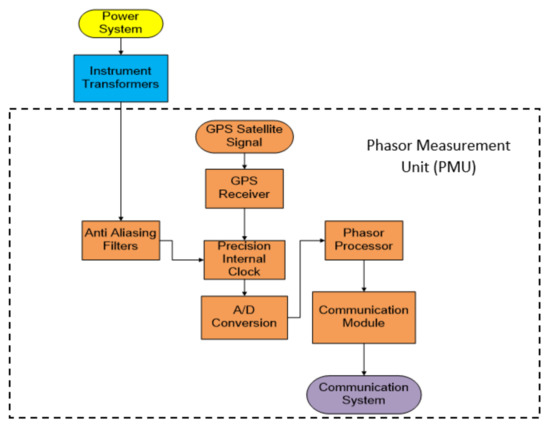
Figure 1.
Basic structure of PMUs.
The wide-area measurement system (WAMS), which consists of PMU and Phasor Data Concentrators (PDC), is a synchronized measurement system that covers a wider domain [18]. Figure 2 shows the wide-area measurement system of the PMU, where PMUs are connected with the specific data concentrator, and the data concentrator sends the data to the monitoring side.
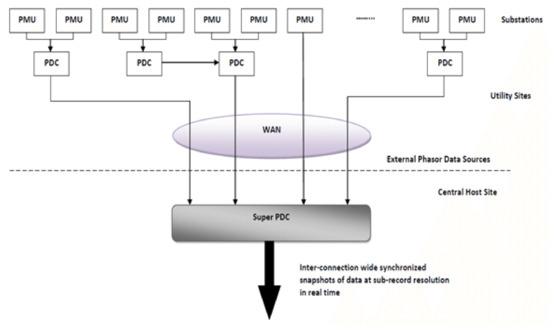
Figure 2.
Wide-area measurement system (WAMS).
The PMU data are, then, transmitted to PDC as part of a smart grid’s wide-area monitoring and control (WAMC) function, which sorts and produces single-time synchronized data that are forwarded to the application device.
Data processing is shown in Figure 3. Layer 1’s responsibility is to measure the data and send them to Layer 2, which is the data management layer. This layer receives all the sent measured data from the PMU. Once data are received by PDC, they are then forwarded to the data service layer. The data service layer works with the data to prepare them for use, and the data application begins once the data are ready.
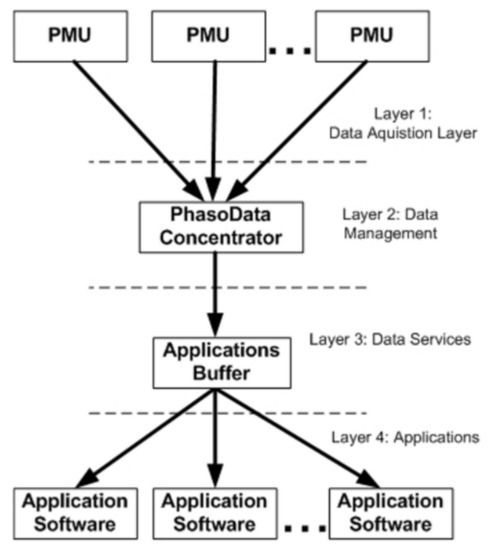
Figure 3.
Illustration of the layer and components of WAMC.
2. Discussion on the Application of the PMU
This section discusses the major applications of PMU data. A PMU can generate 2.6 billion data by 30 samples/s, which means that, to discover the disturbances from the PMU data, intensive data analytics are required [18]. Many researchers have worked on several applications based on PMU data. For detecting transient events from massive PMU data, a fluctuation analysis approach has been used. The Naive Bayes classifications method was proposed for transient power quality assessment [19]. The challenges of dealing with massive PMU data have been discussed [20]. Sequence-based synthesis approach to detect fault type and fault location spots have been discussed in [21]. Their proposed algorithm builds up into two levels: the first level uses voltage magnitude for detecting the fault and the second level spots faults using the current angle difference. However, when the pair of those conditions are unable to detect and locate the fault, then another state is constructed on the current magnitude. The contribution of this research work is that this algorithm can detect short circuit faults but cannot detect an open circuit fault. In [22], a wavelet technique-based algorithm was proposed, which is only applicable to short-circuit faults. A balanced system PMU protection scheme was discussed in [23,24,25]. Different phasor estimation techniques were reviewed in [9]. In [12], the authors introduced the wide-area monitoring system (WAMS) technology. Zero crossing techniques for estimating phasor is one of the significant techniques in [26]. Deflected case studies based on micro-PMUs have been explained [27,28,29,30,31,32,33], where monitoring and fault detection applications using PMU data are analyzed. A multivariate statistical analysis has been proposed for detecting islanding using PMU data [34]. In the latter article, the authors also considered PMU missing data. In [35], a multiple linear regression approach was offered to identify the anomalies in the power network. In [36], the applications of PMU incorporated with FACTS were presented. Several phasor estimation techniques were discussed in [37]. An explanation of PMU area monitoring techniques was discussed in [38]. A phase angle-based wide-area islanding detection scheme was discussed in [39].
Table 1 illustrates the real-time PMU data of 313 MW Orrington, USA, grids. The timestamp of the sampling rate is 30 samples/s. If we look at the frequency column, we see that there is a continuous variable that indicates the disturbances, which influences the grid frequency. Bus 345_M and Bus345_A indicate the magnitude and voltage angle data. As shown in Figure 4, the data were collected from LBNL open-source micro-PMU [40,41], where the left-side digits represent the timestamp and the right-side number is the angle of the current/voltage. Each micro-PMU device is able to produce 12 streams in 100 nanoseconds. One of the major issues of PMU data is data redundancy, which was discussed in [42,43,44,45], and several approaches that focus on data security enhancement were discussed in [46,47,48].

Table 1.
The 313 MW Orrington PMU data [40].
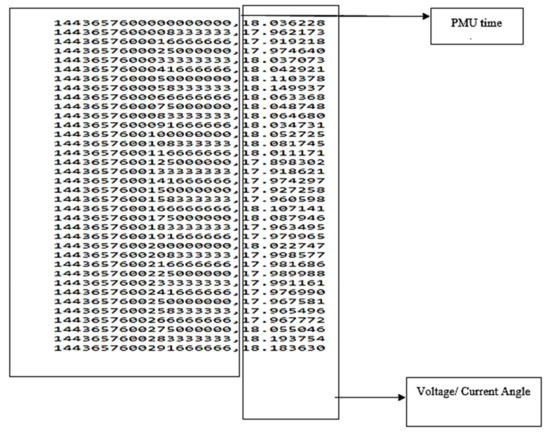
Figure 4.
The Micro-PMU real data.
3. Discussion on Islanding Detection
3.1. Islanding and Risk of Islanding
When a segment or portion of the distribution network is electrically isolated from the upstream network or the main grid, but the isolated part remains energized by one or few DGs, it can be defined as islanding. Islanding is also known as loss of grid or loss of mains (LOM) due to this behavior. An island can be built in various locations with varying voltage levels, involving one or more distribution feeders and DGs. In most cases, islanding occurs as a result of a recloser or circuit breaker opening in response to a fault on the downstream side. Before the start of the islanding, the DG safety relay should detect the fault and trip the DG. If the DG protection schemes fail or a manual switching operation of the circuit breaker happens, then an islanding situation can also occur in the network.
Presently, the probability of sustained islanding has increased substantially due to the fast broadening of DG penetration. As a consequence, in recent years, this phenomenon has caused concern. There are much different protection and operational issues that have risen by unintentional islanding. It can cause the tripping of the circuit breaker once faults or any disturbances happen in the network, as shown in Figure 5.
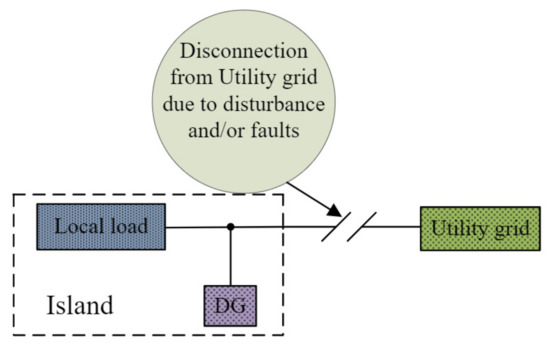
Figure 5.
Schematic diagram of the distributed generation (DG) islanding.
The possibility of power quality degradation can happen due to the active and reactive power mismatch between load and generation. A deviation in the frequency and voltage can occur due to this mismatch, which can further damage the equipment of the customers and be hazardous for the system equipment. The DG unit might face damage during the reconnection of the grid due to the reclosing of the circuit breakers in an out-of-phase state. A sizeable transient current originates at the time of the grid-side reconnection as the DG is most likely to be out of synchronism with the grid side, which will damage the DG unit. Lastly, line employees are at risk from unintentional islanding due to the absence of protection. The island segment remains electrically active or energized by the DG even when they assume it is electrically inactive or disconnected [48]. Furthermore, islanding could leave a portion of the utility system exposed, making the islanded portion potentially insecure and posing serious safety and health risks [49]. As a result, IEEE Standard 1547-2003 mandates islanding detection within 2 s [48].
3.2. Review of Islanding Detection Schemes
Before adopting the loss of mains (LOM) protection schemes, it is significant to explore and understand the characteristics of the DG unit. There are two forms of DG, including rotor-based DG and inverter-based DG. Rotor-based DGs are constructed with an induction generator or synchronous generator, while inverter-based DGs support rotating and non-rotating devices [49,50,51]. The LOM protection for the synchronous-type distributed generator is the most difficult of these tasks due to the limited control options for large generators to provide islanding detection [51]. Furthermore, the synchronous generator aggravates the scenario of creating and controlling the island [51]. The remainder of this section concentrates on the significant anti-islanding techniques associated with synchronous DGs, considering the value of LOM protection for synchronous DGs.
In Figure 6, anti-islanding schemes can be divided into two groups based on their working mechanisms: local detection and communication-based methods. There are two types of local detection methods: active and passive. The following section describes the operational procedures and performance of these techniques.
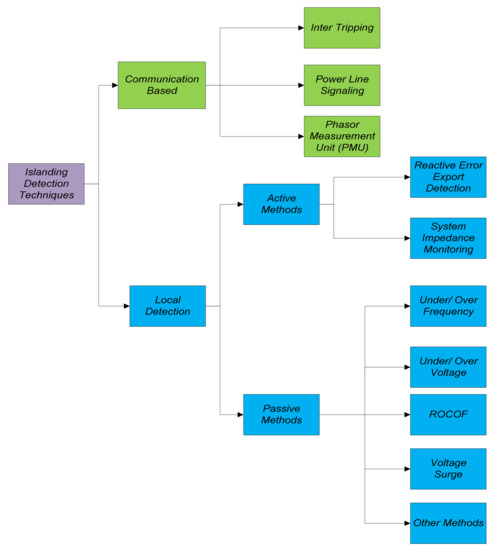
Figure 6.
Classification of islanding detection techniques.
3.2.1. Communication-Based Techniques
An activated alert is sent through the telecommunication system to trip up the DG in communication-based techniques. The efficacy of this method does not depend on the types of connected DG. Because non-detection zone issues do not constrain it, this method is reliable for islanding detection. However, at the infrastructure level, this technique necessitates a substantial investment to be implemented. Therefore, it is less promising for small DG units in terms of economics than local detection schemes. Based on the recent advancements in the communication domain, it is likely that more affordable communication options will become available in the near future. This method is advantageous in the application of anti-islanding techniques. Reliability is another significant concern if the communication system and LOM protection are both unable to operate. The following are some examples of communication-based techniques.
- Inter-Tripping Scheme: This technique takes advantage of communication ties between nodes in the system to ensure that DG units are disconnected correctly in response to LOM detection [35]. This scheme is also called a transfer trip [52] as it monitors the status of all circuit breakers and reclosers, which might cause an islanding event [46,51]. A trip signal is sent to the respective DG when a switching operation occurs due to a utility network disconnection to avoid the island’s building. A variety of mediums, including radio waves, leased telephone lines, and hard wires, can be used to transmit this trip signal.
- Power Line Signaling: This scheme is very similar to the previous inter-tripping scheme, except that it disconnects the power line as a medium. Therefore, it is also known as part of the inter-tripping techniques [52]. However, this scheme requires only a single transmitter, where other schemes require more transmitters at every potential disconnection point in the network. The transmitter is located on the secondary side of the substation bus on the utility bus as it generates signals. It broadcasts a low-energy signal incessantly, which each DG’s receiver receives through the power line. Islanding conditions are considered when failure happens to sense the signal and immediately activate the disconnection of the DG units [51]. For anti-islanding protection, this method can be very effective. However, the cost of the signal generator and its installation may be very costly, rendering this technique uneconomical, especially when a few DG units share the service. Furthermore, signal interference with other forms of power line communication applications, such as automatic meter reading, should be considered.
3.2.2. Active Islanding Detection Method
Active detection methods inject disturbances into the system and focus on the system’s response to detect islanding events [52]. When it comes to detecting islands, this method is more reliable than other passive methods. The advantage of the active technique is the minimum NDZ, but it decreases the power quality. Furthermore, introducing too many disturbances in the system may result in instability [53]. The following are some examples of active techniques.
- Reactive Error Export Detection (REED): This relay’s interface is linked to the AVR (automatic voltage regulator) of the DG, allowing it to operate the DG and generate a specific level of reactive power flow between the utility grid and the local site. This condition can only be sustained when the grid is connected. The relay’s operation allows the actual and desired reactive power deviation to be exported within a predefined time period [46,54,55]. This relay is extremely effective at detecting islands because it can identify islands even if the generator’s loading is not changed. However, the operational time of this relay is slow, taking 2–5 s to detect. Due to the late functional activity of this relay, it is used as backup protection along with “faster” anti-islanding schemes. The effectiveness of this relay fails in the inverter-based DG system since those DGs operate with a unit power factor.
- System Impedance Monitoring: When the DG and utility run in parallel, the system impedance measured at the DG’s terminal is controlled by the utility, and this is very small compared with the islanding formation case. This scheme takes up this role and measures the changes in the system impedance to detect an islanding event [56]. The authors of [57,58] proposed a method for calculating system impedance by injecting a small high-frequency (HF) signal into the system voltage. Due to the transient network frequency, this relay is free from nuisance triggering and operates at a very high speed. Furthermore, because there is a minor power imbalance on the island, this relay lacks an NDZ. However, the effectiveness of this scheme might face difficulties if there is more than one DG on the developed island. In addition, injecting disturbances may degrade the power quality of multiple DGs. The cost of implementation is also a significant concern, as this scheme necessitates installing a signal generator at each DG end [46].
3.2.3. Passive Methods for Islanding Detection
Passive methods observe locally available network parameters to detect LOM [59]. It is underpinned by the premise that a LOM would induce an observable deviation in the network parameters, i.e., voltage and frequency [60]. As a result, abnormal DG activities can be easily detected by deviations in one of those parameters [46]. The most significant advantage of this method is that there is no power quality issue as it does not interfere with the normal operation of the system. Furthermore, in this method, no communication system is required, which makes the system a cost-effective option. However, the drawback of this method is that it is unable to set a threshold for detecting islands when the DG capacity is matched with the connected feeder load [24]. The following are some examples of passive islanding detection schemes.
- Under/Over Frequency Relay: As it runs in parallel with the upstream utility grid, the DG maintains a consistent, constant frequency under steady-state conditions. By using a frequency limit, this scheme can be used for islanding detection. For this scheme, the threshold should be defined to be out of the range of normal operational limits. From the guidance, the recommended settings for under frequency are 49.8 Hz, and for over frequency, 51 Hz [61]. However, this scheme is comparatively slower as the frequency does not change immediately. In addition, this scheme fails to set the threshold for the match frequency islanding condition [24]. A large area of NDZ can exist due to insufficient sensitivity as this scheme highly depends on large-scale power imbalance, which might potentially increase the probability of islanding formation [46]. Given these disadvantages, these relays are used as a backup security measure for the system.
- Under/Over Voltage Relay: Voltage is also a significant parameter that is generally used for islanding detection [46]. The working principle of this relay is very similar to the under/over frequency relay. When there is a reactive power imbalance on the island, the relay operation is activated. Changes happen in the voltage level due to the power balance, and this imbalance indicator can be considered as an islanding parameter. Since there is no mechanical inertia, the response of this method is comparatively faster than the under/over frequency [46]. The threshold setting of this relay should be outside of the statutory level of voltage. From the guidelines, the standard settings should be +10%/6% of the nominal voltage [62]. The tripping operation of the DG occurs once the voltage exceeds the defined limit. However, this relay can create nuisance triggers since it is affected by many disturbances on the network. Furthermore, this method is not effective at detecting islanding events when generation and loads are closely matched [24]. As a result, if it was not for the generator and load variation pushing the voltage to its limit, the island might not be detected.
- Rate of Change of Frequency (ROCOF) Relay: This method is most widely used for detecting unintentional islanding events. The detection process of this method is based on the premise that there is always an imbalance between generators and loads when an island is formed [46,63]. The resulting power imbalance generates a rapid shift in frequency soon after islanding, which can be approximated by the following Equation (1) if the governor response is skipped.
This method only takes into account changes in frequency and ignores faults [46]. The triggering method of this relay is when the corresponding slope of the frequency (df/dt) crosses the predefined threshold setting and vice-versa. For the 50 Hz system, the typical threshold setting is from 0.1 Hz/s to 1 Hz/s [51]. The effectiveness of the settings relies on the system, so if the system is weaker, the setting should be stronger [46]. In most cases, ROCOF is thought to be a sensitive and accurate method for detecting LOM in a distribution network. However, this relay fails when the power imbalance of the island is small. This method is unable to differentiate between actual islanding and a transient event in the system [51]. As a result, false operations may occur as a result of this method, compromising the system’s integrity and the scheme’s dependability. Apparently, in [51], the authors found a flaw in the responding time of ROCOF, where this ROCOF relay responds differently to the same event and to the same scheme setting when the ROCOF relay comes from different manufacturers. This phenomenon might have happened since different techniques were employed. A ROCOF relay can be considered as a possible option for islanding detection. However, due to NDZ limitations, this relay is unable to provide useful protection when the load-generation imbalance on the island is minimal. In addition, due to the network transience, excessive nuisance triggering can occur, such as load switching and frequency excursion.
- Vector Surge (VS) Relay: At each rising zero crossing of the terminal voltage, vector surge relays measure the time duration of an electrical cycle and begin a new calculation [51]. A comparison approach happens between the current cycle (measured waveform) and the previous one (reference cycle). The island situation’s cycle duration is determined by the power imbalance in the island system, as shown in Figure 7. The input parameter of a VS relay is the proportional variation of the terminal voltage. A trip signal is sent to the circuit breaker instantly when the variation in the terminal voltage exceeds the limits of the pre-specified threshold. This threshold adjustment of a vector surge relay is normally allowed to be in the range of from 2 degree to 2 degree. Another important feature is the minimal terminal voltage, which is provided by the block function. When the terminal voltage drops below the adjusted level of the threshold of Vmin, the trip signal of the VS relay is blocked. This phenomenon happens to avoid the actuation of the VS relay during short circuits or generator startup conditions.
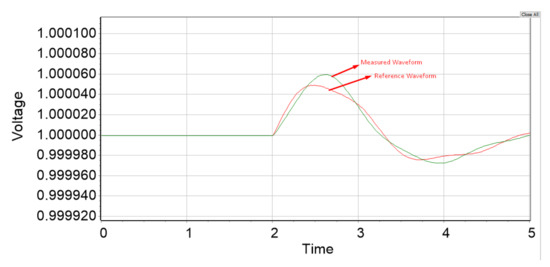
Figure 7.
Operational characteristics of a voltage surge relay [58].
This voltage surge relay can be categorized as a type of frequency relay as both relay principles are to measure the cycle duration of the voltage waveform [58]. Therefore, this relay suffers from the NDZ during the match frequency islanding conditions. Furthermore, this relay is responsive to a network fault on a nearby feeder. For other transient networks, such as load switching, this relay operation is not suitable as it causes a false trigger [46]. This relay’s malfunction was described in [41,58]. The false operation of this relay can be minimized by increasing the threshold setting, but it will hamper the detection time of the relay. Given the detection time, the threshold setting of this relay should not be compromised.
- Other Passive Techniques: Decision tree (DT) classifier, fuzzy rule-based classifier, and bi-orthogonal 1.5 wavelet-based techniques were discussed in [59,60,61] as passive techniques. For an inverter interface DG system, wavelet-based techniques were discussed in [6], and for detecting islanding events, the voltage unbalance and total harmonic distortion (THD) of currents were proposed in [63]. As extension theory-based methods, ROCOV (rate of change of voltage) and ROCOF indices-based methods were presented in [64,65]. In [66,67], the authors proposed a new hybrid method. The coefficient of the negative sequence voltage and transformation of the current wavelet were used [68]. For an inverter-based DG, a passive method was discussed in [68], which exploits parameters such as ROCPAD (rate of change of phase angle difference) and the proportional power spectral density of the voltage. For detecting islanding events, an S-transform-based cumulative sum detector (CUSUM) method was presented in [69], and a data mining approach was explained and evaluated in [70]. In [71], for an inverter-based DG, the authors evaluated, for islanding detection, seven features and four classifiers: decision trees, radial basis function (RBF), support vector machine (SVM), and probabilistic neural networks. The authors of [72] attempted to detect islanding events in the presence of three different types of DG units: inverter-interfaced DG, synchronous-type DG, and multiple DG units (synchronous-type and/or inverter interfaced DG). They used a random forest (RF) classifier to extract twenty features first, and then four of those features were chosen as input. From the above discussions, the most passive islanding detection methods, such as ROCOF, VS, and over/under voltage and over/under frequency relays, suffer from the NDZ limitation. The NDZ function determines the power imbalance on the island. There are two types of power imbalance in the island event: active power imbalance and the reactive power imbalance [73]. The plane in Figure 8a depicts a specific power imbalance situation on the island where there is a power imbalance (positive value of surplus power).
In Figure 8a, the detection time associated with the operating point is illustrated using the third axis. If a required detection time is defined, there will be cases where P and Q values are insufficient to cause anti-islanding relays to detect the islanding in a timely manner. A NDZ is described by these cases or points in the Plane 1 versus Plane 2, as shown in Figure 8b.
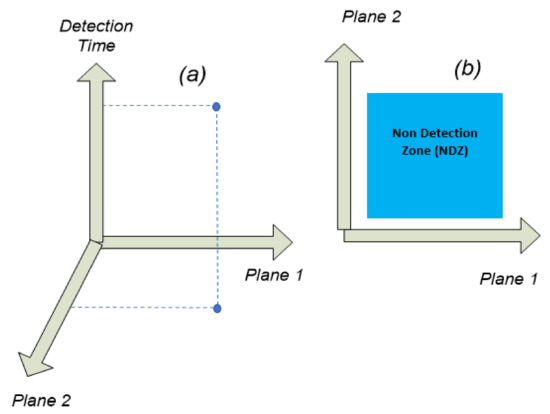
Figure 8.
Power mismatch plane to illustrate the power imbalance and associated NDZ. (a) Detection time for a given power imbalance case and (b) Plane 1 versus Plane 2 to illustrate the NDZ [73].
4. Review of the PMU Island Detection and Data Analytics Techniques
This section presents a brief literature review on PMU data analytic techniques and islanding detection schemes.
4.1. PMU Techniques for Islanding Detection
The dynamic output of PMUs in the power system, as well as the distribution of PMUs at different locations, can be used to determine multi-area estimation. PMU detection can thus be accomplished by processing fundamental frequency, voltage, and current phasors with synchronized harmonic phasors. To improve detection when islanding occurs, power systems must be controlled and coordinated over a larger area [74]. This is particularly true for power transmission that take place over long ranges on the island. When power transmission is involved in different control areas, the PMU is capable of wide-range detection without causing network disruption [75]. The PMU can receive information from large stretches and solve large-scale systems that other techniques cannot handle. However, it is not simple to solve the large-scale framework for islanding detection. The following are some of the most important aspects of the PMU technique:
- Measured parameters are accurate.
- Able to deliver more precise data.
- The error is minimal when compared to conventional measurements.
- Capable of providing islanding detection for the match frequency conditions between DG and the utility.
A synchronized PMU is needed for improved islanding detection that is accurate and precise. PMU is able to measure the phasor value of the voltage and current. In comparison with conventional measurements, such as power injection and power flow measurements, the error in the PMU is minimal. Some conventional methods can influence the system when injecting some disturbances into the network, but PMU is free from this issue. However, there are the following drawbacks to that PMU technique:
- Communication delays when transmitting the time stamp in actual time are due to the shared or dedicated medium [17].
- There is a possibility of missing data points due to technical issues with the PMU’s multiple components [76,77].
For a safe operation, a PMU that falls under the communication-based method group must be able to observe variations that do not exceed 1.15 or 0.85 per unit voltage and are within ±1.5 Hz frequency of their nominal value. However, aliasing will occur if oscillations are greater than 0.5 Hz above the nominal frequency and if the frequency is less than 0.5 Hz below the nominal frequency, which can corrupt oscillations. The islanding detection algorithm can be triggered when the frequency and voltage values reach the safe limit. In [77], the sampling method report for the transmission network described that those PMU technique-based algorithms could be taken as an accurate algorithm when the error is less than 1%. Table 2 presents the islanding detection algorithm using PMU parameters.

Table 2.
Islanding detection algorithms using PMU parameters.
Table 2.
Islanding detection algorithms using PMU parameters.
| Ref. | Objectives | Contributions | Limitations |
|---|---|---|---|
| [78] | Islanding detection uses the frequency parameter of the PMU. | By establishing an appropriate threshold, the proposed algorithm is capable of avoiding false tripping. | The NDZ was not taken into account by the algorithm. |
| [79,80,81,82,83] | Detect an islanding event using rotor angle and phasor using the PMU’s data [79]. | The proposed algorithm can predict when faults will occur and when they will be cleared. | The proposed algorithms did not consider DG-utility match frequency conditions. |
| Detects islanding using islanding detection monitoring factor, rate of change of inverse hyperbolic cosecant function, and voltage at the point of common coupling as the islanding detection elements with the help of the PMU [80]. | The algorithm is quick, reliable, and secure in discriminating between islanding and no islanding scenarios. | ||
| A hybrid transient stability assessment model has been proposed for controlled islanding [80]. | The proposed islanding strategy works well for preventing transient instability. | ||
| Proposed a PMU-based controlled system separation scheme for the Argentinian electric system [81]. | Capable of mitigating the effects of severe fault events. | ||
| Proposed a PMU-based islanding detection algorithm based on the voltage angle [82,83]. | From practical and actual-time implementation point of views, this method proves to be easy, less time-consuming, and cost-efficient. | ||
| [84] | Detect islanding events of the large photovoltaic power station by collecting frequencies from the PMU. | The proposed algorithm is able to detect islanding events with less false triggerings during islanding events. | There is no definite mechanism or technique for determining threshold frequency and time. |
| [85] | A linear programming formulation-based island detection algorithm was proposed. | The proposed method is able to detect islanding events with a faster detection time. | The algorithm is unable to detect islanding events when there is a match frequency condition occurring between the DG and the utilities. |
| [86] | To detect islanding events by using frequency data from the PMU. | Computational time was reduced by minimizing the number of required communications. | |
| [87] | To protect DG from islanding events by using the voltage angle as an input. | The proposed algorithm is simple and easy to implement. | There is no detailed explanation or calculation for determining the threshold values. |
According to the preceding discussions, there are several islanding detection methods, but only a few that work in the match frequency islanding conditions. However, the existing algorithm that works for detecting the match frequency required a longer detection time. In addition, differentiating between an actual islanding event and a transient fault is also an important portion of the islanding detection algorithm, but most literature instances only show the transient fault inside the grid, excluding the island formation.
4.2. PMU Data Analytic Techniques
Several techniques have been employed to scrutinize PMU big data. The significant approaches of PMU data analytic techniques are presented in Table 3.

Table 3.
Summary of PMU data analytic techniques.
Table 3.
Summary of PMU data analytic techniques.
| Approach | Objectives | Methodology | Contributions | Limitations |
|---|---|---|---|---|
| Density Estimation [88] | Proposed data extraction algorithm from millions of PMU data. | Density estimation on the frequency variable of all the samples in a file to extract PMU data. | The algorithm is able to detect long-term and short-term disturbances in the line. | Higher computational time |
| Zero-Crossing [89] | Phasor estimation. | A two bus by using two synchronized 50 Hz reference signal is used to generate phase difference. | Can calculate phase estimation properly. | Cannot detect several fault events |
| Discrete Fourier Transform (DFT) | Phasor estimation. | Sampling and comparing the phase differences from different sites [26,41,49]. | Can calculate phase estimation. | Unable to deal with the missing PMU data without further modification. |
| Slide Discrete Fourier Transform (SDFT) [46] | Phasor estimation. | Sampling the data and apply SDFT to observe and compare with the DFT. | Computation time is lower compared to the DFT. | For finding the appropriate result, the previous value of SDFT must be known. |
| UPS: Unified PMU-Data Storage System [90] | D-PMU (Distribution PMU) data storage. | Unified PMU Data Storage (UPS) system was proposed for D-PMU (Distribution PMU). | Higher efficiency in big data processing. | Unable to deal with the missing PMU data without further modification. |
| PMU Data Recovery [91] | Data recovery | Developed spline interpolation function for recovering PMU data. | Missing PMU data can be recovered. | The algorithm cannot detect, if in time, fault event data were missing; how rapidly the missing data will be recovered and adjusted with the implemented calculation was not explained. |
| PMU Data Screening [92] | PMU data screening. | Data screening theory was applied in PMU big data. | Algorithm can detect an event by screening PMU data. | Unable to deal with the missing PMU data without further modification. |
| Voltage Sag Detection [93] | Power quality monitoring using PMU. | Proposed technique measured a single line to ground faults by using PMUs. | Algorithm can detect fault events. | Unable to deal with the missing PMU data without further modification. |
| Parallel Detrended Fluctuation Analysis (PDFA) [94,95] | Detect transient events of the power grid. | Applied that theory for PMU data screening. | Can calculate the big data of PMU. | Higher computational time is needed. |
4.3. Islanding Detection Techniques
This section discusses the various PMU-based islanding detection schemes. Most islanding detection schemes were developed by the PMU frequency and phase angle data.
4.3.1. Frequency-Based Islanding Detection
Figure 9 shows a frequency difference-based islanding detection algorithm for a 100 MVA nominal power PV station and 50 MVA nominal power DG where the grid is 35 KV nominal voltage. Here, generation trips occur in 0.3 s or 1 s (Figure 9a,b). Once the generation trip occurs, a solid fluctuation of frequency happens. In this case, the PV-based system shows genuine recovery compared to the synchronous-based grid.
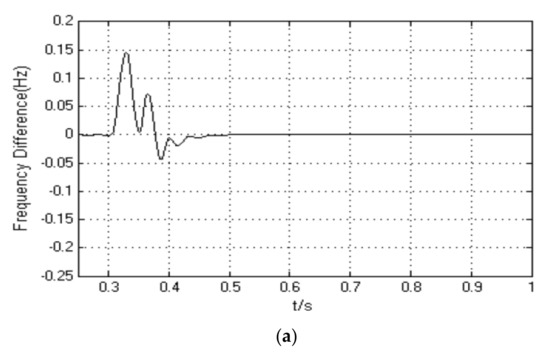
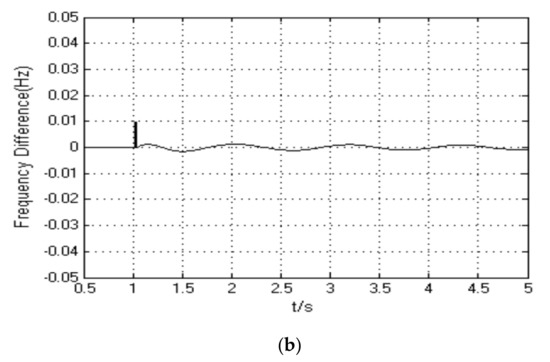
Figure 9.
Frequency difference of two PMUs while a generation trip occurs [56].
Figure 10 presents the result of the DG system where a PV is working as a DG and the system configuration is 208 V and 1.5 KVA constant power. In this case, the breaker opens at 3 s and the microgrid frequency shows a substantial drift. The threshold was set at 60.5 Hz, which exceeds 4.7 s.
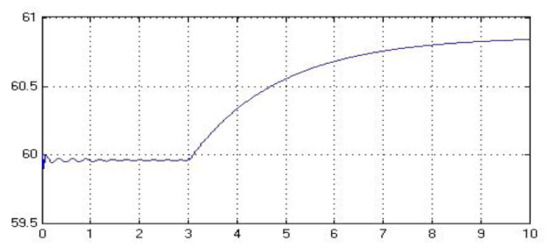
Figure 10.
PMU-based islanding detection using frequency data [57].
Figure 11 shows a frequency plot of experimental data, which are recorded from six different sites in the UK’s power system [34]. To create an islanding event, in this case, an inter-connected trip happened at 02:48:37 and generation loss started and lasted for 5 h. A corresponding event happened in the evening, at 18:17:15 of the same day, which lasted for 1 h and 22 min.

Figure 11.
Frequency plot for detecting islanding events [34].
From Figure 10, Figure 11 and Figure 12, we can observe that there are different frequency plots, which are different from each other, since they considered different forms of frequency. In Figure 9, frequency difference is considered, instead of system frequency (50/60 Hz). On the other hand, Figure 11 and Figure 12 show different frequencies (50 Hz and 60 Hz). However, the frequency plots are different between them since they do not have the same electrical system.

Figure 12.
PMU phase angle used for detecting islanding events [34].
4.3.2. Phase-Angle-Based Islanding Detection
Figure 12 shows a phase angle difference plot where an inter-connected trip happened at 2:48:37, and it drifts closely for 5 h. The main drawback that makes the scheme less reliable is that it uses probabilistic component analysis (PCA) on the phase angle data and assumes a normal distribution, but the phase angle difference component typically shows a non-Gaussian and non-linear behavior.
Figure 13 shows an islanding detection algorithm for a six-bus power system where voltage and current phasors were considered. In this case, the islanding event occurs at 0.02 s; afterwards, the voltage phasor angles change gradually. There is an alarming situation for reverse power flow when some edges located in the islanding zone in that timeline current have a serrated phase shift of or radian. Here, I14, I21, I23, I25, I54, I56 presents the different buses current angle. Figure 14 shows the island detection technique using the phasor measurement unit bus voltage angle of the actual Utility Kerteh, Malaysia system [17]. In this work, the PMU was installed at the utility bus (PAKA) voltage angle and the DG bus (GTG-G-1) to receive the bus voltage angle. In addition, the authors considered two different island conditions, namely over frequency (Figure 14a) and under frequency (Figure 14b), where over frequency happens when the DG capacity is higher than the connected feeder load and under frequency happens when the DG capacity is lower than the connected feeder load.

Figure 13.
Current phasor and voltage phasor angle for detecting islanding events [58].
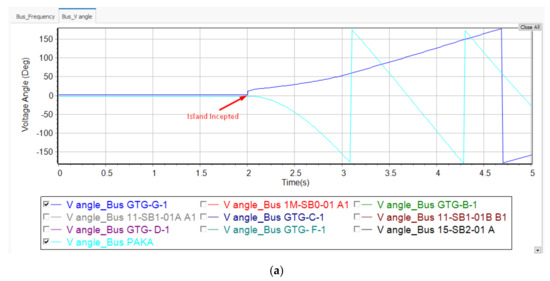
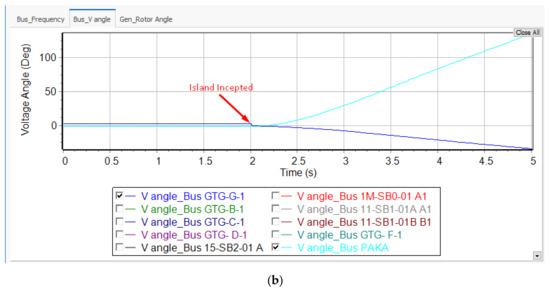
Figure 14.
Island detection of the over frequency (a) and under frequency (b) conditions using the bus voltage angle [17].
For islanding detection, one of the most important criteria is the transient behavior of the voltage and current phasor since the detection algorithm is based on this behavior. Equation (2) shows the voltage and current phasor movement during normal time or before islanding time and after islanding time.
In this case, c is a constant value before islanding, which means there are no changes in the voltage or current phasor, but after islanding, a random value j can be added or misused from the constant value and make the system unreliable or unstable. Phasor measurement unit data is essential for the conversion systems such as DC converters for gird-connected inverters as stated in [96] that climate change has become a major concern over the past years due to the conventional power generation sources and their devices which can be overcome by the conversion system and modern metering devices.
5. Conclusions
The aim of this review article was to ensure the higher reliability of micro-grids since conventional protection technologies are facing challenges by the proliferation of micro-grid technologies. This paper discussed the contributions and limitations of various research articles on PMU data analytics and islanding event detection techniques. This research work will be most useful to researchers who are embarking on PMU research. By improving the significant limitations of the proposed schemes, it will be possible to develop more symmetrical, improvised PMU data analytic and island event detection schemes that will contribute to enhancing the entire grid reliability. This paper showed some substantial future scope of this research are, which is discussed in the subsequent section.
6. Future Scopes
This paper presents several significant future directions in the area of islanding detection schemes by using Phasor Measurement Unit data. The future scopes include the following:
- Develop a robust algorithm for islanding events based on PMU data.
- Increasing the accuracy of the islanding signal.
- Detect and predict the missing PMU data for creating a more vigorous algorithm.
- Reducing false triggers during the fault event.
- Minimizing the computational time of PMU big data analysis.
- PMU economic aspects related to grid reliability in the islanding event.
Author Contributions
Conceptualization, A.A.A., M.B. and G.E.M.A.; formal analysis, M.B., R.K., N.S.S.S. and N.B.M.N.; supervision, N.S.S.S., R.K. and M.B.; methodology, M.B., M.A.S., G.E.M.A. and N.M; software, G.E.M.A., N.M. and M.B; writing original draft, A.A.A.; review and editing, N.S.S.S., R.K. and N.M. All authors have read and agreed to the published version of the manuscript.
Funding
This research was sponsored by the INTI International University, Malaysia, in terms of software simulation from the beginning to its publication.
Acknowledgments
The authors wish to extend their sincere thanks to the support of Centre of Graduate Studies, Universiti Teknologi, PETRONAS, Malaysia and Faculty of Data Science and Information Technology, INTI International University, Malaysia for providing state-of-the-art research facilities to carry on this work. In addition, the authors are also thankful for the support provided by the collaborators from Condition Monitoring System, National Centre of Robotics and Automation, Mehran University of Engineering and Technology, Jamshoro, Sindh Pakistan. The entire project was sponsored by the Faculty of Data Science and Information Technology, INTI International University, Malaysia, to achieve the necessary results.
Conflicts of Interest
The authors declare no conflict of interest.
References
- Phadke, A.G.; Thorp, J.S.; Adamiak, M.G. A new measurement technique for tracking voltage phasors, local system frequency, and rate of change of frequency. IEEE Trans. Power Appar. Syst. 1983, 5, 1025–1038. [Google Scholar] [CrossRef]
- Nanda, P.; Panigrahi, C.; Dasgupta, A. Phasor Estimation and Modelling Techniques of PMU-A Review. Energy Procedia 2017, 109, 64–77. [Google Scholar] [CrossRef]
- Phadke, A.G.; Thorp, J.S. Synchronized Phasor Measurements and Their Applications; Springer: New York, NY, USA, 2008. [Google Scholar]
- Huang, Z.; Kasztenny, B.; Madani, V.; Martin, K.; Meliopoulos, S.; Novosel, D.; Stenbakken, J. Performance Evaluation of Phasor Measurement Systems. In Proceedings of the IEEE Power and Energy Society General Meeting-Conversion and Delivery of Electrical Energy in the 21st Century, Pittsburgh, PA, USA, 20–24 July 2008. [Google Scholar]
- Phadke, A.G.; Volskis, H.; De Moraes, R.M.; Bi, T.; Nayak, R.N.; Sehgal, Y.K.; Sen, S.; Sattinger, W.; Martinez, E.; Samuelsson, O.; et al. The Wide World of Wide-area Measurement. IEEE Power Energy Mag. 2008, 6, 52–65. [Google Scholar] [CrossRef]
- Huang, C.; Li, F.; Zhan, L.; Xu, Y.; Hu, Q.; Zhou, D.; Liu, Y. Data quality issues for synchrophasor applications Part II: Problem formulation and potential solutions. J. Mod. Power Syst. Clean Energy 2016, 4, 353–361. [Google Scholar] [CrossRef]
- Yao, W.; Liu, Y.; Zhou, D.; Pan, Z.; Till, M.J.; Zhao, J.; Liu, Y. Impact of GPS Signal Loss and Its Mitigation in Power System Synchronized Measurement Devices. IEEE Trans. Smart Grid 2016, 9, 1141–1149. [Google Scholar] [CrossRef]
- Jones, K.D.; Pal, A.; Thorp, J.S. Methodology for performing synchrophasor data conditioning and validation. IEEE Trans. Power Syst. 2014, 30, 1121–1130. [Google Scholar] [CrossRef]
- Huang, C.; Li, F.; Zhou, D.; Guo, J.; Pan, Z.; Liu, Y.; Liu, Y. Data quality issues for synchrophasor applications Part I: A review. J. Mod. Power Syst. Clean Energy 2016, 4, 342–352. [Google Scholar] [CrossRef]
- Baba, M.; Nor, N.B.M.; Ibrahim, T.B.; Sheikh, M.A. A comprehensive review for optimal placement of phasor measurement unit for network observability. Indones. J. Electr. Eng. Comput. Sci. 2020, 19, 301–308. [Google Scholar] [CrossRef]
- Baba, M.; Nor, N.; Sheikh, M.A.; Baba, A.M.; Irfan, M.; Glowacz, A.; Kozik, J.; Kumar, A. Optimization of Phasor Measurement Unit Placement Using Several Proposed Case Factors for Power Network Monitoring. Energies 2021, 14, 5596. [Google Scholar] [CrossRef]
- Baba, M.; Nor, N.B.M.; Sheikh, M.A.; Irfan, M.; Tahir, M. A strategic and significant method for the optimal placement of phasor measurement unit for power system network. Symmetry 2020, 12, 1174. [Google Scholar] [CrossRef]
- Aravind, M.N.; Mathew, A.T. PMU data-based post disturbance analysis for a large grid using wavelets and Lyapunov Exponent. In Proceedings of the IEEE National Power Systems Conference (NPSC), Bhubaneswar, India, 19–21 December 2016. [Google Scholar]
- Kezunovic, M.; Meliopoulos, S.; Venkatasubramanian, V.; Vittal, V. Transmission Line Fault Location. In Application of Time-Synchronized Measurements in Power System Transmission Networks; Springer: Warsaw, Poland, 2014. [Google Scholar]
- Hashmy, Y.; Yu, Z.; Shi, D.; Weng, Y. Wide-area measurement system-based low frequency oscillation damping control through reinforcement learning. IEEE Trans. Smart Grid 2020, 11, 5072–5083. [Google Scholar] [CrossRef]
- Liu, Y.; Wu, L.; Li, J. D-PMU based applications for emerging active distribution systems: A review. Electr. Power Syst. Res. 2020, 179, 106063. [Google Scholar] [CrossRef]
- Eghbali, O.; Kazemzadeh, R.; Amiri, K. Multi-area state estimation based on PMU measurements in distribution networks. J. Oper. Autom. Power Eng. 2020, 8, 65–74. [Google Scholar]
- Dotta, D.; Chow, J.H.; Vanfretti, L.; Almas, M.S.; Agostini, M.N. A matlab-based PMU simulator. In Proceedings of the IEEE Power & Energy Society General Meeting, Vancouver, BC, Canada, 21–25 July 2013. [Google Scholar]
- Arefin, A.; Hasan, K.; Othman, M.; Romlie, M.; Saad, N.; Nor, N.; Abdullah, M. A Novel Island Detection Threshold Setting Using Phasor Measurement Unit Voltage Angle in a Distribution Network. Energies 2021, 14, 4877. [Google Scholar] [CrossRef]
- Pinte, B.; Quinlan, M.; Yoon, A.; Reinhard, K.; Sauer, P.W. A one-phase, distribution-level phasor measurement unit for post-event analysis. In Proceedings of the IEEE Power and Energy Conference at Illinois (PECI), Champaign, IL, USA, 28 February–1 March 2014. [Google Scholar]
- Arefin, A.A.; Hasan, K.N.M.; Romlie, M.F.; Abdullah, M.F.; Ali, M.L.; Othman, M.L. Determining Islanding Operation Using Micro Grid Phasor Measurement Unit Parameters. Int. J. Emerg. Trends Eng. Res. 2020, 8, 97–101. [Google Scholar] [CrossRef]
- Bhuiyan, S.M.; Khan, J.F.; Murphy, G.V. Big data analysis of the electric power PMU data from smart grid. In Proceedings of the IEEE SoutheastCon, Concord, NC, USA, 30 March–2 April 2017; pp. 1–5. [Google Scholar]
- Zhiwei, H.; Tian, G.; Huaving, Z.; Xu, H.; Junwei, C.; Ziheng, H.; Zhengguo, Z. Transient Power Quality Assessment Based on Big Data Analysis. In Proceedings of the China International Conference on Electricity Distribution, Shenzhen, China, 23–26 September 2014. [Google Scholar]
- Yang, B.; Yamazaki, J.; Saito, N.; Kokai, Y.; Xie, D. Big data analytic empowered grid applications is PMU a big data issue? In Proceedings of the IEEE 12th International Conference on the European Energy Market, Lisbon, Portugal, 19–22 May 2015; pp. 1–4. [Google Scholar]
- Khan, A.Q.; Ullah, Q.; Sarwar, M.; Gul, S.T.; Iqbal, N. Transmission Line Fault Detection and Identification in an Interconnected Power Network using Phasor Measurement Units. IFAC-Pap. 2018, 51, 1356–1363. [Google Scholar] [CrossRef]
- Zhou, J.P.; Zheng, Y.P.; Wang, Z.P. Detection of the transmission line short-circuited fault based on lifting wavelet. In Proceedings of the Third IEEE International Conference on Electric Utility Deregulation and Restructuring and Power Technologies, Nanjing, China, 6–9 April 2008. [Google Scholar]
- Chen, C.S.; Liu, C.W.; Jiang, J.A. A new adaptive PMU based protection scheme for transposed/untransposed parallel transmission lines. IEEE Trans. Power Deliv. 2002, 17, 395–404. [Google Scholar] [CrossRef]
- Jiang, J.A.; Yang, J.Z.; Lin, Y.H.; Liu, C.W.; Ma, J.C. An adaptive PMU based fault detection/location technique for transmission lines. I. Theory and algorithms. IEEE Trans. Power Deliv. 2000, 15, 486–493. [Google Scholar] [CrossRef]
- Jiang, J.A.; Lin, Y.H.; Yang, J.Z.; Too, T.M.; Liu, C.W. An adaptive PMU based fault detection/location technique for transmission lines. II. PMU implementation and performance evaluation. IEEE Trans. Power Deliv. 2000, 15, 1136–1146. [Google Scholar] [CrossRef]
- Milos, S.; Krumpholc, M. Digital Measurement of Phase Difference—A Comparative Study of DSP Algorithms; Czech Technical University: Prague, Czech Republic, 2012. [Google Scholar]
- Shahsavari, A.; Farajollahi, M.; Stewart, E.M.; Cortez, E.; Mohsenian-Rad, H. Situational Awareness in Distribution Grid Using Micro-PMU Data: A Machine Learning Approach. IEEE Trans. Smart Grid 2019, 10, 6167–6177. [Google Scholar] [CrossRef]
- Mohsenian-Rad, H.; Stewart, E.; Cortez, E. Distribution synchro-phasors: Pairing big data with analytics to create actionable information. IEEE Power Energy Mag. 2018, 16, 26–34. [Google Scholar] [CrossRef]
- Shahsavari, A.; Sadeghi-Mobarakeh, A.; Stewart, E.; Cortez, M.; Alvarez, E.; Megala, L.; Mohsenian-Rad, H. Distribution grid reliability versus regulation market efficiency: An analysis based on micro-PMU data. IEEE Trans. Smart Grid 2016, 8, 2916–2925. [Google Scholar] [CrossRef]
- Farajollahi, M.; Shahsavari, A.; Stewart, E.M.; Mohsenian-Rad, H. Locating the Source of Events in Power Distribution Systems Using Micro-PMU Data. IEEE Trans. Power Syst. 2018, 33, 6343–6354. [Google Scholar] [CrossRef]
- Shahsavari, A.; Farajollahi, M.; Stewart, E.; von Meier, A.; Alvarez, L.; Cortez, E.; Mohsenian-Rad, H. A data-driven analysis of capacitor bank operation at a distribution feeder using micro-PMU data. In Proceedings of the IEEE Power & Energy Society Innovative Smart Grid Technologies Conference (ISGT), Washington, DC, USA, 23–26 April 2017; pp. 1–5. [Google Scholar] [CrossRef]
- Shahsavari, A.; Farajollahi, M.; Stewart, E.; Roberts, C.; Megala, F.; Alvarez, L.; Cortez, E.; Mohsenian-Rad, H. Autopsy on active distribution networks: A data-driven fault analysis using micro-PMU data. In Proceedings of the IEEE North American Power Symposium (NAPS), Morgantown, WV, USA, 17–19 September 2017; pp. 1–7. [Google Scholar] [CrossRef]
- Shahsavari, A.; Farajollahi, M.; Stewart, E.; Roberts, C.; Mohsenian-Rad, H. A data-driven analysis of lightning-initiated contingencies at a distribution grid with a PV farm using Micro-PMU data. In Proceedings of the IEEE North American Power Symposium (NAPS), Morgantown, WV, USA, 17–19 September 2017; pp. 1–6. [Google Scholar] [CrossRef]
- Liu, X.A.; Laverty, D.; Best, R. Islanding detection based on probabilistic PCA with missing values in PMU data. In Proceedings of the IEEE PES General Meeting Conference & Exposition, National Harbor, MD, USA, 27–31 July 2014; pp. 1–6. [Google Scholar] [CrossRef]
- Rafferty, M.; Brogan, P.; Hastings, J.; Laverty, D.; Liu, X.A.; Khan, R. Local Anomaly Detection by Application of Regression Analysis on PMU Data. In Proceedings of the IEEE Power & Energy Society General Meeting (PESGM), Portland, OR, USA, 5–10 August 2018; pp. 1–5. [Google Scholar] [CrossRef]
- Singh, B.; Sharma, N.; Tiwari, A.; Verma, K.; Singh, S. Applications of phasor measurement units (PMUs) in electric power system networks incorporated with FACTS controllers. Int. J. Eng. Sci. Technol. 2011, 3. [Google Scholar] [CrossRef]
- Modi, P.; Kamboj, S.G. Modeling of phasor measurement unit (PMU) using various phasor estimation techniques in Matlab. Ph.D. Thesis, Thapar University, Punjab, India, 2015. [Google Scholar]
- Rahman, W.U.; Ali, M.; Ullah, A.; Rahman, H.U.; Iqbal, M.; Ahmad, H.; Zeb, A.; Ali, Z.; Shahzad, M.A.; Taj, B. Advancement in Wide Area Monitoring Protection and Control Using PMU’s Model in MATLAB/SIMULINK. Smart Grid Renew. Energy 2012, 3, 294–307. [Google Scholar] [CrossRef]
- Liu, X.; Kennedy, J.M.; Laverty, D.; Morrow, D.J.; McLoone, S. Wide-Area Phase-Angle Measurements for Islanding Detection—An Adaptive Nonlinear Approach. IEEE Trans. Power Deliv. 2016, 31, 1901–1911. [Google Scholar] [CrossRef]
- Ukil, A.; Zivanovic, R. Automated analysis of power systems disturbance records: Smart grid big data perspective. In Proceedings of the IEEE Innovative Smart Grid Technologies-Asia (ISGT ASIA), Kuala Lumpur, Malaysia, 20–23 May 2014; pp. 126–131. [Google Scholar]
- Stewart, E.; Liao, A.; Roberts, C. Open μpmu: A Real-World Reference Distribution Micro-Phasor Measurement Unit Data Set for Research and Application Development; Lawrence Berkeley National Laboratory: Berkeley, CA, USA, 2016. [Google Scholar]
- Niaki, A.H.M.; Afsharnia, S. A new passive islanding detection method and its performance evaluation for multi-DG systems. Elect. Power Syst. Res. 2014, 110, 180–187. [Google Scholar] [CrossRef]
- Chen, J.; Abur, A. Placement of PMUs to Enable Bad Data Detection in State Estimation. IEEE Trans. Power Syst. 2006, 21, 1608–1615. [Google Scholar] [CrossRef]
- Denegri, G.; Invernizzi, M.; Milano, F. A security oriented approach to PMU positioning for advanced monitoring of a transmission grid. In Proceedings of the International Conference on Power System Technology, Kunming, China, 13–17 October 2002; pp. 798–803. [Google Scholar]
- Yang, Q.; An, D.; Min, R.; Yu, W.; Yang, X.; Zhao, W. On Optimal PMU Placement-based Defense against Data Integrity Attacks in Smart Grid. IEEE Trans. Inf. Forensics Secur. 2017, 12, 1735–1750. [Google Scholar] [CrossRef]
- Dan, G.; Sandberg, H. Stealth Attacks and Protection Schemes for State Estimators in Power Systems. In Proceedings of the First IEEE International Conference on Smart Grid Communications, Gaithersburg, MD, USA, 4–6 October 2010. [Google Scholar] [CrossRef]
- Jamei, M.; Stewart, E.; Peisert, S.; Scaglione, A.; McParland, C.; Roberts, C.; McEachern, A. Micro Synchrophasor-Based Intrusion Detection in Automated Distribution Systems: Toward Critical Infrastructure Security. IEEE Internet Comput. 2016, 20, 18–27. [Google Scholar] [CrossRef]
- Mazloomzadeh, A.; Mohammed, O.A.; Zonouzsaman, S.; Zonouz, S. Empirical Development of a Trusted Sensing Base for Power System Infrastructures. IEEE Trans. Smart Grid 2015, 6, 2454–2463. [Google Scholar] [CrossRef]
- Mondal, S.; Murthy, C.; Roy, D.S.; Mohanta, D.K. Simulation of phasor measurement unit (PMU) using LabVIEW. In Proceedings of the 14th IEEE International Conference on Environment and Electrical Engineering, Krakow, Poland, 10–12 May 2014. [Google Scholar]
- Jain, A.; Bhardwaj, A.; Kumar, S.; Bhullar, S. Implementation Techniques for Frequency Phasor Estimation in Phasor Measurement Units (PMUs). In Proceedings of the 3rd IEEE International Conference on Internet of Things: Smart Innovation and Usages (IoT-SIU), Bhimtal, India, 23–24 February 2018. [Google Scholar]
- Jain, A.; Verma, M.K. Development of DFT based MATLAB and LABVIEW Models for Phasor Measurements. Int. J. Inf. Electron. Eng. 2016, 6, 331–336. [Google Scholar] [CrossRef]
- Kumar, S.; Soni, M.K.; Jain, D.K. Power quality monitoring using PMU. Int. J. Comput. Appl. 2016, 135, 1–5. [Google Scholar] [CrossRef]
- Rafii, Z. Sliding Discrete Fourier Transform with Kernel Windowing [Lecture Notes]. IEEE Signal Process. Mag. 2018, 35, 88–92. [Google Scholar] [CrossRef]
- Kosen, I.; Huang, C.; Chen, Z.; Zhang, X.; Min, L.; Zhou, D.; Zhu, L.; Liu, Y. UPS: Unified PMU-Data Storage System to Enhance T+D PMU Data Usability. IEEE Trans. Smart Grid 2019, 11, 739–748. [Google Scholar] [CrossRef]
- Allen, A.J.; Sohn, S.W.; Santoso, S.; Grady, W.M. Algorithm for screening PMU data for power system events. In Proceedings of the 3rd IEEE PES Innovative Smart Grid Technologies Europe (ISGT Europe), Berlin, Germany, 14–17 October 2012. [Google Scholar]
- Freitas, W.; Xu, W.; Huang, Z.; Vieira, J.C. Characteristics of vector surge relays for distributed synchronous generator protection. Electr. Power Syst. Res. 2006, 77, 170–180. [Google Scholar] [CrossRef]
- Samantaray, S.R.; El-Arroudi, K.; Joos, G.; Kamwa, I. A Fuzzy Rule-Based Approach for Islanding Detection in Distributed Generation. IEEE Trans. Power Deliv. 2010, 25, 1427–1433. [Google Scholar] [CrossRef]
- Thomas, M.S.; Terang, P.P. Islanding detection using decision tree approach. In Proceedings of the IEEE Joint International Conference on Power Electronics, Drives and Energy Systems, New Delhi, India, 20–23 December 2010; pp. 1–6. [Google Scholar]
- Pigazo, A.; Liserre, M.; Mastromauro, R.A.; Moreno, V.M.; Dell’Aquila, A. Wavelet-Based Islanding Detection in Grid-Connected PV Systems. IEEE Trans. Ind. Electron. 2008, 56, 4445–4455. [Google Scholar] [CrossRef]
- Lidula, N.W.A.; Rajapakse, A.D. A Pattern Recognition Approach for Detecting Power Islands Using Transient Signals—Part I: Design and Implementation. IEEE Trans. Power Deliv. 2010, 25, 3070–3077. [Google Scholar] [CrossRef]
- Hanif, M.; Dwivedi, U.; Basu, M.; Gaughan, K. Wavelet based islanding detection of DC-AC inverter interfaced DG systems. In Proceedings of the 45th IEEE International Universities Power Engineering Conference (UPEC), Cardiff, UK, 31 August 2010–3 September 2010; pp. 1–5. [Google Scholar]
- Jang, S.-I.; Kim, K.-H. An Islanding Detection Method for Distributed Generations Using Voltage Unbalance and Total Harmonic Distortion of Current. IEEE Trans. Power Deliv. 2004, 19, 745–752. [Google Scholar] [CrossRef]
- Chao, K.-H.; Chiu, C.-L. An intelligent islanding detection method based-on extension theory for photovoltaic power generation systems. In Proceedings of the in IEEE International Symposium on Computer Communication Control and Automation (3CA), Tainan, Taiwan, 5–7 May 2010; pp. 171–174. [Google Scholar] [CrossRef]
- Chang, W.-Y. An Islanding Detection Method for Grid-Connected Inverter of Distributed Renewable Generation System. In Proceedings of the 2011 Asia-Pacific Power and Energy Engineering Conference (APPEEC), Wuhan, China, 25–28 March 2011; pp. 1–4. [Google Scholar] [CrossRef]
- Chang, W.-Y. A hybrid islanding detection method for distributed synchronous generators. In Proceedings of the 2010 International Power Electronics Conference, Sapporo, Japan, 21–24 June 2010; pp. 1326–1330. [Google Scholar] [CrossRef]
- Martin, D.; Wu, K.H.; Chen, C.L.; Lai, J.S. Phase lock loop design and novel test schemes for islanding detection. In Proceedings of the IEEE 8th International Conference on Power Electronics and ECCE Asia (ICPE & ECCE), Jeju, Korea, 30 May–3 June 2011; pp. 1793–1800. [Google Scholar]
- Samantaray, S.; Pujhari, T.M.; Subudhi, B. A new approach to islanding detection in distributed generations. In Proceedings of the in IEEE International Conference on Power Systems, Kharagpur, India, 27–29 December 2009; pp. 1–6. [Google Scholar] [CrossRef]
- Samui, A.; Samantaray, S.R. Assessment of ROCPAD Relay for Islanding Detection in Distributed Generation. IEEE Trans. Smart Grid 2011, 2, 391–398. [Google Scholar] [CrossRef]
- Yin, J.; Diduch, C.P.; Chang, L. Islanding Detection Using Proportional Power Spectral Density. IEEE Trans. Power Deliv. 2008, 23, 776–784. [Google Scholar] [CrossRef]
- Lee, S.H.; Park, J.W. New islanding detection method for inverter-based distributed generation considering its switching frequency. IEEE Trans. Ind. Appl. 2010, 46, 2089–2098. [Google Scholar] [CrossRef]
- Vieira, J.C.M.; Freitas, W.; Xu, W.; Morelato, A. An Investigation on the Nondetection Zones of Synchronous Distributed Generation Anti-Islanding Protection. IEEE Trans. Power Deliv. 2008, 23, 593–600. [Google Scholar] [CrossRef]
- Zargar, B.; Angioni, A.; Ponci, F.; Monti, A. Multiarea Parallel Data-Driven Three-Phase Distribution System State Estimation Using Synchrophasor Measurements. IEEE Trans. Instrum. Meas. 2020, 69, 6186–6202. [Google Scholar] [CrossRef]
- Appasani, B.; Jha, A.V.; Mishra, S.K.; Ghazali, A.N. Communication infrastructure for situational awareness enhancement in WAMS with optimal PMU placement. Prot. Control Mod. Power Syst. 2021, 6, 1–12. [Google Scholar] [CrossRef]
- Osipov, D.; Chow, J.H. PMU Missing Data Recovery Using Tensor Decomposition. IEEE Trans. Power Syst. 2020, 35, 4554–4563. [Google Scholar] [CrossRef]
- Saber, A. PMU–Based fault location method for Three–terminal transmission lines with outage of one line branch. Electr. Power Syst. Res. 2020, 182, 106224. [Google Scholar] [CrossRef]
- Tang, Y.; Sun, R.; Thomas, K.; Burgos, R. Synchro phasor based Transmission System Anti-Islanding Scheme. In Proceedings of the IEEE Power & Energy Society General Meeting, Chicago, IL, USA, 16–20 July 2017; pp. 1–5. [Google Scholar]
- Kamali, S.; Amraee, T. Prediction of Unplanned Islanding in Power Systems Using PMU Data. In Proceedings of the 2018 IEEE International Conference on Environment and Electrical Engineering and 2018 IEEE Industrial and Commercial Power Systems Europe (EEEIC / I&CPS Europe), Palermo, Italy, 12–15 June 2018; pp. 1–5. [Google Scholar]
- Radhakrishnan, R.M.; Sankar, A.; Rajan, S. A combined islanding detection algorithm for grid connected multiple microgrids for enhanced microgrid utilisation. Int. Trans. Electr. Energy Syst. 2019, 30, e12232. [Google Scholar] [CrossRef]
- Tang, Y.; Li, F.; Zheng, C.; Wang, Q.; Wu, Y. PMU Measurement-Based Intelligent Strategy for Power System Controlled Islanding. Energies 2018, 11, 143. [Google Scholar] [CrossRef]
- Candelino, M.; Scheinkman, M.; Anello, M.; Del Rosso, A. PMU-based Controlled System Separation Case Study for the Argentinean High Voltage Interconnection System. In Proceedings of the in IEEE PES Innovative Smart Grid Technologies Conference-Latin America (ISGT Latin America), Gramado, Brazil, 15–18 September 2019; pp. 1–6. [Google Scholar] [CrossRef]
- Dutta, S.; Sadhu, P.K.; Reddy, M.J.B.; Mohanta, D.K. Smart inadvertent islanding detection employing p-type μPMU for an active distribution network. IET Gener. Transm. Distrib. 2018, 12, 4615–4625. [Google Scholar] [CrossRef]
- Cao, Q.; Liu, F.; Zhu, G.; Chen, W. PMU based islanding detection method for large photovoltaic power station. In Proceedings of the IEEE International Conference on Power Electronics and Drive Systm, Sydney, NSW, Australia, 9–12 June 2015; pp. 126–131. [Google Scholar] [CrossRef]
- Kyriacou, A.; Demetriou, P.; Panayiotou, C.; Kyriakides, E. Controlled Islanding Solution for Large-Scale Power Systems. IEEE Trans. Power Syst. 2017, 33, 1591–1605. [Google Scholar] [CrossRef]
- Liu, F.; Chen, X.; Zhang, D.; Zhu, G.; Chen, W. A Test Device for Optimize PMU-based Islanding Detection Technology. Procedia Comput. Sci. 2015, 52, 788–795. [Google Scholar] [CrossRef]
- Skok, S.; Frlan, K.; Ugarkovic, K. Detection and Protection of Distributed Generation From Island Operation by Using PMUs. Energy Procedia 2017, 141, 138–142. [Google Scholar] [CrossRef]
- Dubey, R.; Popov, M.; Samantaray, S.R. Transient monitoring function-based islanding detection in power distribution network. IET Gener. Transm. Distrib. 2018, 13, 805–813. [Google Scholar] [CrossRef]
- Admasie, S.; Bukhari, S.B.A.; Haider, R.; Gush, T.; Kim, C.-H. A passive islanding detection scheme using variational mode decomposition-based mode singular entropy for integrated microgrids. Electr. Power Syst. Res. 2019, 177, 105983. [Google Scholar] [CrossRef]
- Kumar, D.; Bhowmik, P.S. Artificial neural network and phasor data-based islanding detection in smart grid. IET Gener. Transm. Distrib. 2018, 12, 5843–5850. [Google Scholar] [CrossRef]
- Matik-Cuka, B.; Kezunovic, M. Islanding detection for inverter based distributed generation using support vector machine method. IEEE Trans. Smart Grid 2014, 5, 2676–2686. [Google Scholar] [CrossRef]
- Manikonda, S.K.; Gaonkar, D.N. Islanding detection method based on image classification technique using histogram of oriented gradient features. IET Gener. Transm. Distrib. 2020, 14, 2790–2799. [Google Scholar] [CrossRef]
- Adari, S.; Bhalja, B.B. Islanding detection of distributed generation using random forest technique. In Proceedings of the 2016 IEEE 6th International Conference on Power Systems (ICPS), New Delhi, India, 4–6 March 2016; pp. 1–6. [Google Scholar]
- Kumar, R.; Kannan, R.; Singh, N.S.S.; Abro, G.E.M.; Mathur, N.; Baba, M. An Efficient Design of High Step-Up Switched Z-Source (HS-SZSC) DC-DC Converter for Grid-Connected Inverters. Electronics 2022, 11, 2440. [Google Scholar] [CrossRef]
Publisher’s Note: MDPI stays neutral with regard to jurisdictional claims in published maps and institutional affiliations. |
© 2022 by the authors. Licensee MDPI, Basel, Switzerland. This article is an open access article distributed under the terms and conditions of the Creative Commons Attribution (CC BY) license (https://creativecommons.org/licenses/by/4.0/).